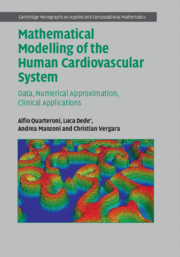24 results
References
-
- Book:
- Mathematical Modelling of the Human Cardiovascular System
- Published online:
- 19 April 2019
- Print publication:
- 09 May 2019, pp 235-275
-
- Chapter
- Export citation
Index
-
- Book:
- Mathematical Modelling of the Human Cardiovascular System
- Published online:
- 19 April 2019
- Print publication:
- 09 May 2019, pp 276-280
-
- Chapter
- Export citation
7 - Beyond direct simulation
- from Part Three - Optimization, Control, Uncertainty And Complexity Reduction
-
- Book:
- Mathematical Modelling of the Human Cardiovascular System
- Published online:
- 19 April 2019
- Print publication:
- 09 May 2019, pp 155-158
-
- Chapter
- Export citation
6 - Modelling the heart
- from Part Two - Heart Function
-
- Book:
- Mathematical Modelling of the Human Cardiovascular System
- Published online:
- 19 April 2019
- Print publication:
- 09 May 2019, pp 102-152
-
- Chapter
- Export citation
2 - An insight into vascular data
- from Part One - Arterial Circulation
-
- Book:
- Mathematical Modelling of the Human Cardiovascular System
- Published online:
- 19 April 2019
- Print publication:
- 09 May 2019, pp 10-24
-
- Chapter
- Export citation
4 - Basic facts on quantitative cardiac physiology
- from Part Two - Heart Function
-
- Book:
- Mathematical Modelling of the Human Cardiovascular System
- Published online:
- 19 April 2019
- Print publication:
- 09 May 2019, pp 79-91
-
- Chapter
- Export citation
Contents
-
- Book:
- Mathematical Modelling of the Human Cardiovascular System
- Published online:
- 19 April 2019
- Print publication:
- 09 May 2019, pp v-vi
-
- Chapter
- Export citation
11 - Reduced-order modelling
- from Part Three - Optimization, Control, Uncertainty And Complexity Reduction
-
- Book:
- Mathematical Modelling of the Human Cardiovascular System
- Published online:
- 19 April 2019
- Print publication:
- 09 May 2019, pp 225-234
-
- Chapter
- Export citation
1 - Basic facts about quantitative physiology
- from Part One - Arterial Circulation
-
- Book:
- Mathematical Modelling of the Human Cardiovascular System
- Published online:
- 19 April 2019
- Print publication:
- 09 May 2019, pp 3-9
-
- Chapter
- Export citation
8 - Control and optimization
- from Part Three - Optimization, Control, Uncertainty And Complexity Reduction
-
- Book:
- Mathematical Modelling of the Human Cardiovascular System
- Published online:
- 19 April 2019
- Print publication:
- 09 May 2019, pp 159-177
-
- Chapter
- Export citation
Frontmatter
-
- Book:
- Mathematical Modelling of the Human Cardiovascular System
- Published online:
- 19 April 2019
- Print publication:
- 09 May 2019, pp i-iv
-
- Chapter
- Export citation
Part Three - Optimization, Control, Uncertainty And Complexity Reduction
-
- Book:
- Mathematical Modelling of the Human Cardiovascular System
- Published online:
- 19 April 2019
- Print publication:
- 09 May 2019, pp 153-154
-
- Chapter
- Export citation
Introduction
-
- Book:
- Mathematical Modelling of the Human Cardiovascular System
- Published online:
- 19 April 2019
- Print publication:
- 09 May 2019, pp vii-x
-
- Chapter
- Export citation
10 - Accounting for uncertainty
- from Part Three - Optimization, Control, Uncertainty And Complexity Reduction
-
- Book:
- Mathematical Modelling of the Human Cardiovascular System
- Published online:
- 19 April 2019
- Print publication:
- 09 May 2019, pp 203-224
-
- Chapter
- Export citation
Part Two - Heart Function
-
- Book:
- Mathematical Modelling of the Human Cardiovascular System
- Published online:
- 19 April 2019
- Print publication:
- 09 May 2019, pp 77-78
-
- Chapter
- Export citation
3 - Modelling blood flow
- from Part One - Arterial Circulation
-
- Book:
- Mathematical Modelling of the Human Cardiovascular System
- Published online:
- 19 April 2019
- Print publication:
- 09 May 2019, pp 25-76
-
- Chapter
- Export citation
Part One - Arterial Circulation
-
- Book:
- Mathematical Modelling of the Human Cardiovascular System
- Published online:
- 19 April 2019
- Print publication:
- 09 May 2019, pp 1-2
-
- Chapter
- Export citation
9 - Parameter estimation from clinical data
- from Part Three - Optimization, Control, Uncertainty And Complexity Reduction
-
- Book:
- Mathematical Modelling of the Human Cardiovascular System
- Published online:
- 19 April 2019
- Print publication:
- 09 May 2019, pp 178-202
-
- Chapter
- Export citation
5 - An insight into cardiac data
- from Part Two - Heart Function
-
- Book:
- Mathematical Modelling of the Human Cardiovascular System
- Published online:
- 19 April 2019
- Print publication:
- 09 May 2019, pp 92-101
-
- Chapter
- Export citation

Mathematical Modelling of the Human Cardiovascular System
- Data, Numerical Approximation, Clinical Applications
-
- Published online:
- 19 April 2019
- Print publication:
- 09 May 2019



